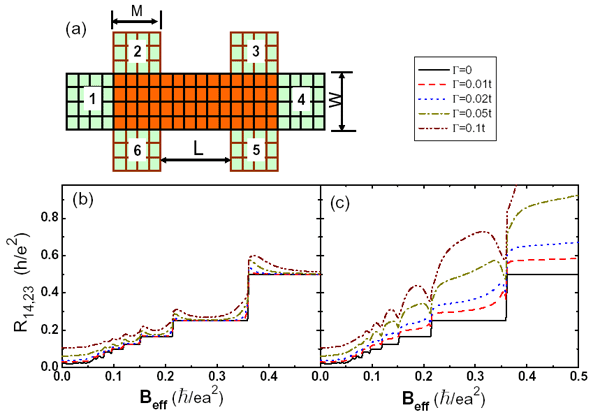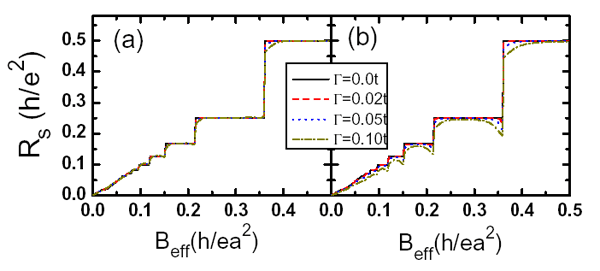Dephasing influence on the quantum spin Hall effect
Date:09-10-2009 Print
Topological insulator is one of the most important research areas in modern condense matter physics. From the viewpoint of the electronic structure, the topological insulator can neither be classified into a metal nor an insulator but a new state of quantum matter. The bulk states of a topological insulator are the gapped insulator states while the surface (3D) or edge (2D) states are gapless metallic states. The quantum Hall effect that induced by a high magnetic field is the first class of topological insultor. Its discovery has exerted profound influence on the modern physic research. In 1985 and 1998 the Nobel Prize were awarded to four scientists for their contributions to the quantum Hall effect. In the last few years, scientists have successively predicted and found experimentally that a new class of topological insulator states can be realized in several types of two dimensional or three dimensional materials under certain conditions. This class of topological insulator, originated from the strong spin orbit coupling in materials while maintaining the time reversal symmetry, is named as the Z2 topological insulator. The quantum spin Hall effect (QSHE) is the first experimental confirmed 2D topological insulator of this class. In a quantum spin Hall sample, due to the strong spin orbit coupling, the carriers only flow along the boundaries and the carriers with opposite spin polarizations move in opposite directions on a given edge. The QSHE was first proposed by Kane and Mele of University of Pennsylvania in graphene [Phys.Rev.Lett.95,226801(2005); 95,146802 (2005)]. Soonafter SC Zhang’s group at University of Standford predicated that QSHE can exist in HgTe/CdTe Quantum wells under certain conditions [Science 314,1757(2006)]. This predication of the QSHE was successfully realized by Laurens Molenkamp group at University of of Wurzburg [Science 318,766(2007)]. In their experiments, the longitudinal resistances of HgTe/CdTe QWs were measured. They observed quantized longitudinal resistance plateaus as the theory predicted, thus indirectly confirmed the QSHE and showed its topological feature. However, in the experiment, the quantized longitudinal resistance plateaus could only emerge in mesoscopic samples. When the sample becomes larger, though the longitudinal resistance approximatively shows the plateau characteristics, the plateau value is far beyond the idealized quantized value. This character is very different from the regular quantum Hall effect. In the quantm Hall effect, the quantized Hall resistance plateaus exist in the macroscopic samples.
In recent five years, the T04 (IOP CAS) group has carried out extensive research in the area of the quantum spin Hall effect and the spintronics. They have obtained several achievements on spin current generation [Phys.Rev.Lett.90,258301(2003), Appl.Phys.Lett.83, 1397(2003)], spin current detection [Phys.Rev.B 77, 195313(2008), Appl.Phys.Lett. 93, 142107 (2008)] , spin current definition [Phys.Rev.B 72,245305(2005)] and characters of spin Hall effect[Phys.Rev.Lett. 97,066603(2006), Phys.Rev.B 75,075324(2007), Phys.Rev. B 77,115346(2008)]. They have also found that spin current could induce an electric filed [Phys.Rev.B 69,054409(2004)] and predicted that there exists a persistent spin current in a spin-orbit coupling system [Phys.Rev.Lett. 98,196801(2007), Phys.Rev.B 77,035327(2008)].
Based on their previous work, the group members Prof. X.C. Xie, Prof. Qing-feng Sun, Mr. Hua Jiang, and Dr. Shuguang Cheng studied the dephasing effect on the QSHE. They found the dephasing processes in a realistic sample can be classified into the two categories. In the first kind, the carriers lose only the phase memory while maintaining the spin memory, such as with the daphasing processes caused by the electron-electron interaction, the electron-phonon interaction etc., these were named as normal dephasing. In the second kind, the carriers lose both phase and spin memories, such as with the spin-flip dephasing processes caused by the magnetic impurities, the nuclear spins, etc., named spin dephasing. They found that the quantized conductance plateaus are robust against the normal dephasing but fragile to the spin dephasing. As shown in figure. 1, with normal dephasing, the plateau structure remains and the longitude resistance changes only slightly as increasing of the dephasing strength. However, with the spin dephasing, the longitude resistance increases significantly even with small dephasing strength. In a real experimental sample, the spin dephasing always exists to some degree, thus the quantum plateaus of longitudinal resistance of QSHE only survive in mesoscopic samples. This explains why the quantum plateau was not observed in samples with large lengths. Moreover, they found that the longitudinal resistance increases linearly with the sample length but is insensitive to the sample width. These characters are in excellent agreement with the recent experimental results. In addition, they defined a new spin Hall resistance that also exhibits quantum plateaus. In particular, these plateaus are robust against both types of dphasings.[see figure. 2] Therefore, these novel quantum plateasus survive in macroscopic samples and better reflect the topological nature of QSHE. The work has been recently published in [Physical Review Letter 103, 036803(2009)】。

Figure. 1 (a)Schematic diagram for a six-terminal Hall bar sample. (b) and (c) illustrate the longitudinal resistance vs. effective magnetic field under different dephasing strength in the presence of normal dephasing (b) and spin dephasing (c).


